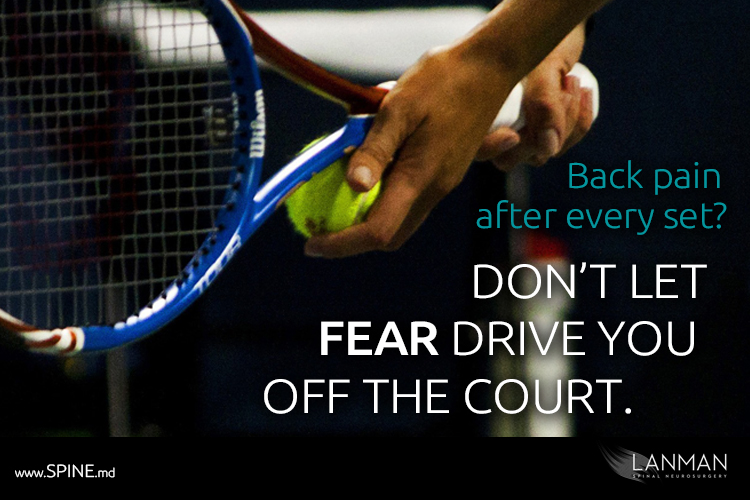Pay attention to the pain, but don’t let fear drive you off the court.
If you play a lot of tennis, just like any athlete, you are at risk for chronic back pain. And there’s always a statistic for something like this: 85% of tennis players say that they experience back pain according to articles published in The American Journal of Sports Medicine and Medicine & Science in Sports & Exercise.
There aren’t statistics on how many tennis players end up with a herniated disc and, eventually, back surgery. But I can imagine that there are quite a few. Much of the problem centers around postural abnormality and general overuse that occurs with hyper back rotation and extension of the serve.
Common sense advice says you should rest for a few days to ease up on the pain in the lower back. Some athletes try to power their way through the pain which is a terrible idea. Pain is your body’s way of warning that you’re risking potential damage to your bones, connecting tissue, and spinal discs.
Again, common sense says that you should always engage a little stretching before you jump onto the court. For almost all of my patients, I recommend squats and spinal extensions in sets before and between play to help prevent further injury to your lower back. I also tell my patients about strength training. For example, exercises for your abdominal muscles and lumbar paraspinal that will help prevent excess intervertebral disc strain. Other strengthening exercises might include straight, and oblique crunches and balance exercises with a yoga ball.
My word of caution for engaging any type of exercise if you currently experience chronic lower back pain: talk to your doctor and get it checked out. I see hundreds of patients at my practice in Beverly Hills, CA – and many of them have the same fear about seeing their doctor about their lower back pain: back surgery.
No matter if you are just an occasional player or an “A” list pro, being told that you need back surgery is not welcome news. You need the full natural range of motion of your spine. Even a single level spinal fusion will take away some of that range of motion.
But who says back surgery HAS to be spinal fusion?
Artificial disc replacement (ADR) is the newest among other treatments for lumbar disc herniations, but it is far from experimental. By the time ADR was granted FDA approval in 2005, the procedure and the implants had undergone extensive clinical trials for more than 15 years. Now we have nearly 15 years of clinical data just in the U.S. alone, almost 30+ years if you include the work that went on before in Europe and Japan. While artificial disc replacement surgery is no more invasive than fusion, studies show better patient outcomes in every way: regarding the reduction of pain complaint, neurological function, and—more important—fewer revision surgeries.
Just a month ago, the FDA approved a new disc implant called “M6-C.” This latest development is different because the core compresses like a natural disc. Previous ADR implants were firm. I believe that M6-C does a better job of mimicking the anatomic structure of a natural disc. And even though it just got FDA approval, it’s far from experimental. This disc implant has actually been in service since 2006 in Europe, and there are more than 45,000 patients who have great post-operative results.
But who says you need an artificial disc?
Maybe you just need to see a doctor and get a professional diagnosis. You may discover that all you need at this point is confidence that you CAN continue playing.
Whatever sport you enjoy, you deserve full painless movement of your spine. When you feel pain, pull back and get checked out. If you’re like many of my athletic patients, you could be seeing a nonsurgical approach that includes some common sense.
That’s how to be greater than better.







